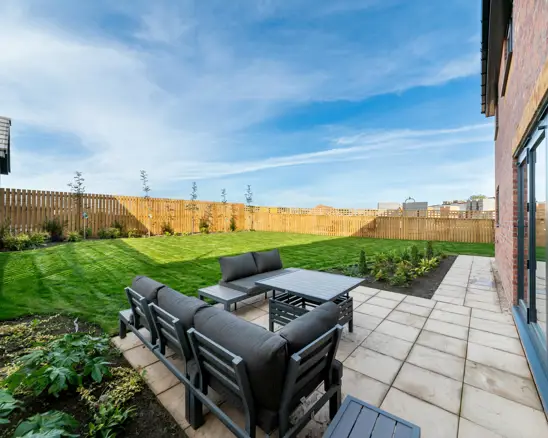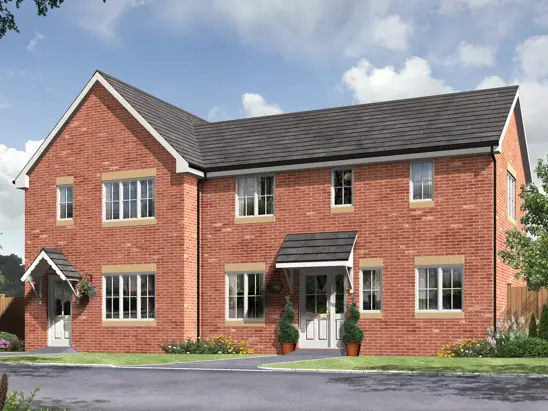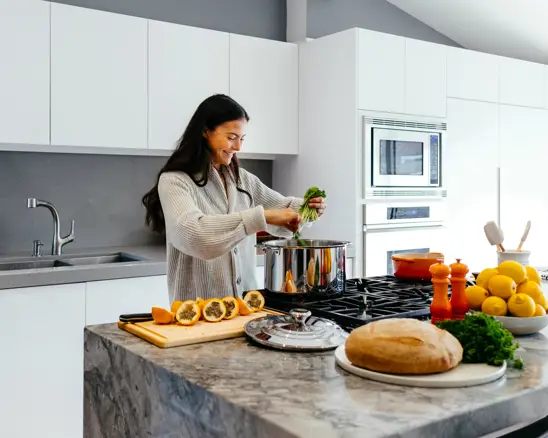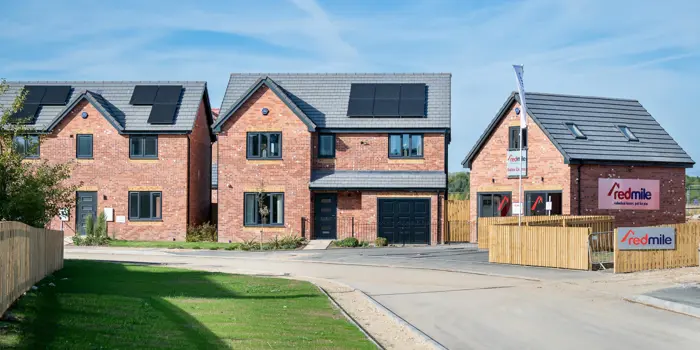
New to buying a home? Here’s everything you need to know as a first-time buyer.
Your complete first-time buyer guide
Buying your first home is exciting, but it can also feel like a lot to take in if you don’t have anyone to guide you through it. Suddenly, you’re surrounded by new words like mortgage broker, stamp duty, conveyancing, exchange of contracts. Don’t worry if you don’t know what they mean yet. Nobody does at the start, and our first-time buyer guide explains everything step by step.

Quick links – jump to a section:
Redmile Homes’ step-by-step first-time buyer guide gives you a clear overview of each stage. Click any section for more detail, or scroll down to read the full guide.
Introduction to key people and terms
If you’re feeling lost in mortgage jargon, don’t panic – most first-time buyers feel the same. Here are the key people and words you’ll come across:
Mortgage broker / advisor
A professional who helps you understand what you can borrow, compares mortgage deals for you, and applies for the mortgage on your behalf. Some are free, while others charge a fee.
Lender / bank / building society
The company actually lending you the money. Even if you use a broker, your mortgage will come from a lender.
Decision in Principle (DIP)
A quick check from a lender showing how much they’re likely to let you borrow, based on your income and credit history. This shows you’re serious about buying during your property search.
Loan-to-Value (LTV) ratio
The amount of money you borrow for a mortgage compared to the property’s value, expressed as a percentage (a lower LTV reduces the lender’s risk, leading to better mortgage rates).
Solicitor / conveyancer
The legal expert who handles contracts, checks the property for legal issues, and makes sure the money is transferred safely. This whole process is called conveyancing.
Estate agent
The person or company selling the property on behalf of the current owner or developer. They’ll pass on your offers and keep the sale moving.
Surveyor
A professional who inspects the property for problems. With resale homes, this could be a RICS surveyor; with new builds, it might be a snagging inspector.
Stamp duty
A UK government tax you pay when buying a property. Most first-time buyers don’t pay unless the property is priced over £300,000.
Management company
If you buy a flat or a new build, a management company often looks after shared spaces, buildings, and the estate. You’ll typically pay a service charge for this.


1. Know what you can afford
Before you start looking at homes, it’s important to understand the full cost of buying. Thinking about everything upfront will help you set a realistic budget and avoid surprises later.
Here’s what to factor in:
- The money you have available now to put down as a deposit
- What you can comfortably afford to pay back each month
- The amount a bank or building society is likely to lend you
- Plot reservation fees, if it’s a new development
- The legal fees for a solicitor to handle contracts and checks
- The cost of getting a survey to check the property for issues
- Stamp Duty Land Tax (SDLT), which most first-time buyers don’t pay unless the property is over £300,000
- The cost of moving itself (removal vans, rental storage units, and so on)
- Furniture and decorating once you’re in
- Your ongoing monthly bills, such as council tax, gas, electricity, water, broadband, insurance, and service charges
First-time buyer mortgage advice: Mortgages explained
For most first-time buyers, the main route is a mortgage. That’s when a lender loans you money to buy a home, and you pay it back monthly with interest.
Mortgage term
Mortgages usually last 25-35 years, though you can choose shorter or longer terms (longer mortgages make the monthly payments smaller, but you’ll pay more interest over time).
Deposit
You’ll normally need to pay at least 5% of the property price upfront. On a £200,000 home, that’s £10,000. If you can stretch to 10% or more, you can often get better mortgage rates (interest percentage).
Fixed rates
Many people opt into a fixed mortgage repayment rate for the first 2-5 years. That means your monthly payments stay the same during that time, even if interest rates go up or down.
Remortgaging
When your fixed deal ends, you’ll automatically switch to your lender’s standard variable rate (SVR), or you can remortgage (often with help from a broker) to find another good deal.
Overpayments
Some lenders let you pay extra on top of your regular monthly mortgage. This can reduce your balance faster and save you interest over time. However, most lenders limit how much you can overpay each year.

Gifted deposits and cash buyers
Gifted deposits: If a family member or friend gives you money for your deposit, lenders usually accept it. They’ll just want a letter confirming it’s a gift, not a loan, and that the gifter has no legal stake in the property.
Cash buyers: If you’re buying outright without a mortgage, the process is simpler. You still need a solicitor, and you’ll still pay fees like surveys and stamp duty (if applicable), but you skip the mortgage stage completely.
Affordable home schemes
There are several affordable home schemes in the UK designed to help you get on the property ladder:

- First Homes Scheme: First-time buyers may be able to purchase a property for 30%-50% less than its market value if they meet certain local council criteria.
- Shared Ownership: Buy a share between 10% and 75% of a home’s full market value, with a smaller deposit and lower monthly payments than purchasing outright.
- Mortgage Guarantee Scheme (Freedom to Buy): The government guarantees part of the mortgage, allowing buyers with just a 5% deposit to access mortgages with a 90-95% loan-to-value (LTV) ratio.
- Right to Buy (England): Those currently renting from the council and some housing associations may be eligible to purchase a home at a discount.
- HOLD (Home Ownership for People with Long-Term Disabilities): A shared ownership program that enables adults with long-term disabilities to buy a share in a property.
- OPSO (Older People’s Shared Ownership): A shared ownership program enabling people aged 55 and over to buy a share in a home, up to 75%.
- Developer Contributions: Some new-build developers offer financial support, such as deposit contributions or covering legal fees, potentially saving buyers thousands.
- LISA (Lifetime Individual Savings Account): You can use a LISA to buy your first home (priced at up to £450,000). Deposit up to £4,000 each year, and the government will contribute a 25% bonus to your savings (up to a maximum of £1,000 per year).
For full details and eligibility criteria, visit the official government website or contact a mortgage broker / solicitor.

Get a Decision in Principle (DIP)
A mortgage broker or advisor can give you a clearer picture of your borrowing power. They’ll review your income, regular expenses, and credit history to help you understand what type of mortgage – and therefore what kind of property – is within reach.
A Mortgage in Principle (MIP) – also called a Decision in Principle (DIP) or Agreement in Principle (AIP) – indicates how much a lender is likely to offer you, based on the financial details you provide.
While it isn’t a formal mortgage offer, it shows sellers and developers that you’re a serious buyer and can help speed things up when you’re ready to reserve or buy a home.
2. Searching for a property
Buying a home in the UK isn’t only about finance – finding the right property is just as important. Here are some useful tips to guide you through your house hunt.

Narrow down your criteria
There’s a lot to weigh up when choosing a property, from practical needs to personal preferences. We’ve put together a detailed guide on what to look for when buying a new house, but here are some of the main points to think about:
- Location and community – Check transport links, schools, work commute, and local amenities.
- Property type and size – Decide whether you want a house, flat, or new build, and how much space you need.
- Energy efficiency – Look at heating systems, insulation, and energy ratings to keep running costs down.
- Layout and features – Consider orientation, the layout of rooms, parking, gardens, and storage.
- Condition – Decide if you’d prefer a move-in-ready home or one that needs some renovation.
Read our full article on what to look for when buying a new home for a more detailed checklist.
Start your search!
Now comes the exciting part – looking for your new home. Make the most of every channel to give yourself the best chance of finding the right property:
- Register with estate agents in the area you like for new listing alerts
- Use property websites like Rightmove or Zoopla to browse homes
- Search for new developments directly through Google, your local council’s website, or developer websites, like Redmile Homes

3. Making an offer
When you find the right home, you’ll need to make an offer through the estate agent. They’ll usually ask about your buying position, including how you plan to pay, the size of your deposit, your mortgage lender’s details, and proof of a Mortgage in Principle (MIP).
At this stage:
- Get advice from your broker – They can guide you on whether to offer below, at, or above the asking price, depending on the property and local market.
- Know when prices are fixed – With some properties, such as new builds or shared ownership homes, the price is usually set and not open to negotiation.
- Don’t be disheartened if your offer is rejected – Sellers may be looking for a higher price, or they might choose buyers in a stronger position.
Good news: as a first-time buyer, you’re not in a “chain” of homeowners each trying to sell and buy a property. That makes you more attractive to sellers, since there’s less risk of the sale falling through.

4. Appointing solicitors
If your offer is accepted, the next step is to appoint a solicitor (sometimes called a conveyancer). They’ll handle the legal side of the purchase and make sure everything is in order. This usually includes:
- Checking for legal issues with the property, such as ownership rights or restrictions
- Carrying out searches with the local authority and other bodies to highlight anything that could affect the property
- Managing contracts and funds, ensuring money is safely transferred between you, your lender, and the seller
The amount of work your solicitor needs to do can vary depending on the property. For example, additional checks may be needed if the home has solar panels, involves a gifted deposit, or is bought through an affordable home scheme. These extra steps may increase the overall cost.
Tip: Get quotes from at least three solicitors to compare the breakdown of costs. The seller or estate agent may suggest a solicitor (and a mortgage broker), but you are still free to choose whoever you prefer to handle your purchase.

5. The conveyancing process
Once you’ve appointed your solicitor, the first step is to provide them with the Memorandum of Sale (MOS). This document confirms the key details of the sale and triggers the legal process. You’ll receive it from the seller, developer, or estate agent after your offer is accepted.
Your solicitor will then:
- Verify your identity through ID and anti-money laundering checks
- Send you initial paperwork, such as a purchase questionnaire (covering details about the property and your circumstances) and a client care letter or agreement (confirming you understand the terms of their service)
- Contact the seller’s solicitor to request documents, raise initial enquiries, arrange property searches, and check financial arrangements
At the same time, let your mortgage broker know your offer has been accepted so they can begin the mortgage application. The lender will carry out a valuation survey to confirm the property is worth the agreed price. You’ll then receive your formal mortgage offer, which sets out repayment terms and conditions. Your solicitor will need this to complete the purchase.
Note: Using a mortgage broker or advisor is optional – you can apply for a mortgage directly. However, brokers can guide you through the process, may access better deals through lender relationships, and can save you time and effort.

Other actions that you might need to take, during the purchase
After your offer is accepted – but before you exchange contracts – there may be extra steps depending on the type of property you’re buying:
- Personalising your property (for new build homes bought off-plan, like Redmile Homes)
- Negotiate inclusions, such as fixtures, fittings, appliances, or curtains (resale homes)
- Arrange a snagging survey (to identify any defects or snags in new build homes)
- Arrange a RICS Level 2 or 3 survey (to check the condition and safety of resale homes)
- Address unexpected issues, such as boundary disputes, missing disclosures, or other problems revealed during the process
Note: Until contracts are exchanged, you can still walk away from the purchase (though you may owe your solicitor or broker for any work already completed).
6. Exchanging contracts and completion day
If you decide to go ahead with the purchase, the next step is exchanging contracts. This is your legally binding commitment to buy the property. After this point, if you pull out, you could face significant costs or penalties from the seller.
Your solicitor will guide you through agreeing on an exchange date (the day you pay your deposit) and a completion date (the day you get the keys). In many cases, both happen on the same day, but sometimes there’s a gap between them to allow for final arrangements.

7. Getting insurance
For new builds, estates are often managed by private companies, and building insurance may already be included in your annual service charge. Your solicitor or management company will confirm what’s covered.
If it isn’t covered – or if you’re buying a resale property – you’ll need to arrange your own building insurance. This is usually a condition of your mortgage agreement.
Regardless of the property type, it’s also recommended that you arrange:
- Contents insurance – to protect your belongings
- Life insurance – particularly if you’re buying with a partner
- Income or illness protection – to cover mortgage payments if you can’t work
Your broker can explain the different types of insurance you’ll need and often arrange them on your behalf as part of their service.

8. Paying any outstanding fees
On completion day, you’ll usually settle your solicitor’s bill. This will be based on the initial quote you received, plus any additional charges for extra work during the process.
Your solicitor will also register the change of ownership with HM Land Registry. Once this is complete, the Land Registry issues an updated Title Register, which your solicitor will pass on to you.
If you’re buying through an affordable home scheme, such as shared ownership, you may also need to pay a portion of your first month’s rent and service charge in advance. Your solicitor will confirm the exact amount and payment date with the housing association or council.
9. Completing personal admin
You’ve reached the finish line: the keys are in your hand and the hardest part is behind you. All that’s left are a few simple admin tasks, like updating your address, setting up utilities, and arranging household services. Once those are sorted, you can settle in and focus on the best part – making your new place feel like home.
Redmile Homes: Your New Homes Specialist
Buying your first home can feel like a marathon of paperwork and decisions, but with the right guidance it becomes far more manageable. We hope our first-time buyer guide has given you a clearer picture of the journey and the confidence to take each step with ease.

Thinking about buying a Redmile home?
Explore our developments and register your interest today.
Request a callback
Frequently asked questions
How do I know if I’m a first-time buyer?
In the UK, you’re considered a first-time buyer if you have never owned a property or land before – anywhere in the world. This includes owning through inheritance or receiving a property as a gift. Even if you’ve never lived in it, having had a legal interest means you no longer count as a first-time buyer.
If you’re buying with someone else, both of you must meet the criteria. If your co-buyer has previously owned a property, the purchase is treated as if neither of you is a first-time buyer.
How to get a mortgage as a first-time buyer?
Speak to a mortgage broker. They’ll look at your income and spending, explain mortgage rates for first-time buyers, and help you get a Decision in Principle (DIP). If you’re unsure who to speak to, ask family, friends, or colleagues for recommendations.
What are Help-to-Buy schemes?
Help-to-Buy schemes are government-backed schemes that make affordable homes more accessible. They include Shared Ownership, the First Homes scheme, and Lifetime ISAs.
How much deposit do you need for a mortgage?
Most lenders ask for at least 5%. However, a higher deposit can unlock better mortgage rates.
How do I get a Mortgage in Principle?
You can get a Mortgage in Principle (MIP), also known as a Decision in Principle (DIP) or Agreement in Principle (AIP), by applying through a broker or lender. They’ll run a credit check and give you a document showing how much you could borrow.
Are mortgage rates different for first-time buyers?
Many lenders offer special mortgage rates for first-time buyers, as well as lower deposit mortgage products, such as 95% loan-to-value (LTV) mortgages, making it easier to get on the property ladder.
Do you pay stamp duty on a new build?
Stamp duty rates for new build homes are generally the same as those for existing properties. However, the way the tax is calculated can differ slightly due to how the final purchase price is determined (e.g., the price of interior upgrades may raise the purchase price above the threshold).
Do first-time buyers pay stamp duty?
First-time buyers don’t pay Stamp Duty Land Tax (SDLT) on any property valued at up to £300,000. This is known as first-time buyer stamp duty relief. You can find out more about the first-time buyer stamp duty rate UK here.

Value for money and a home to be proud of.